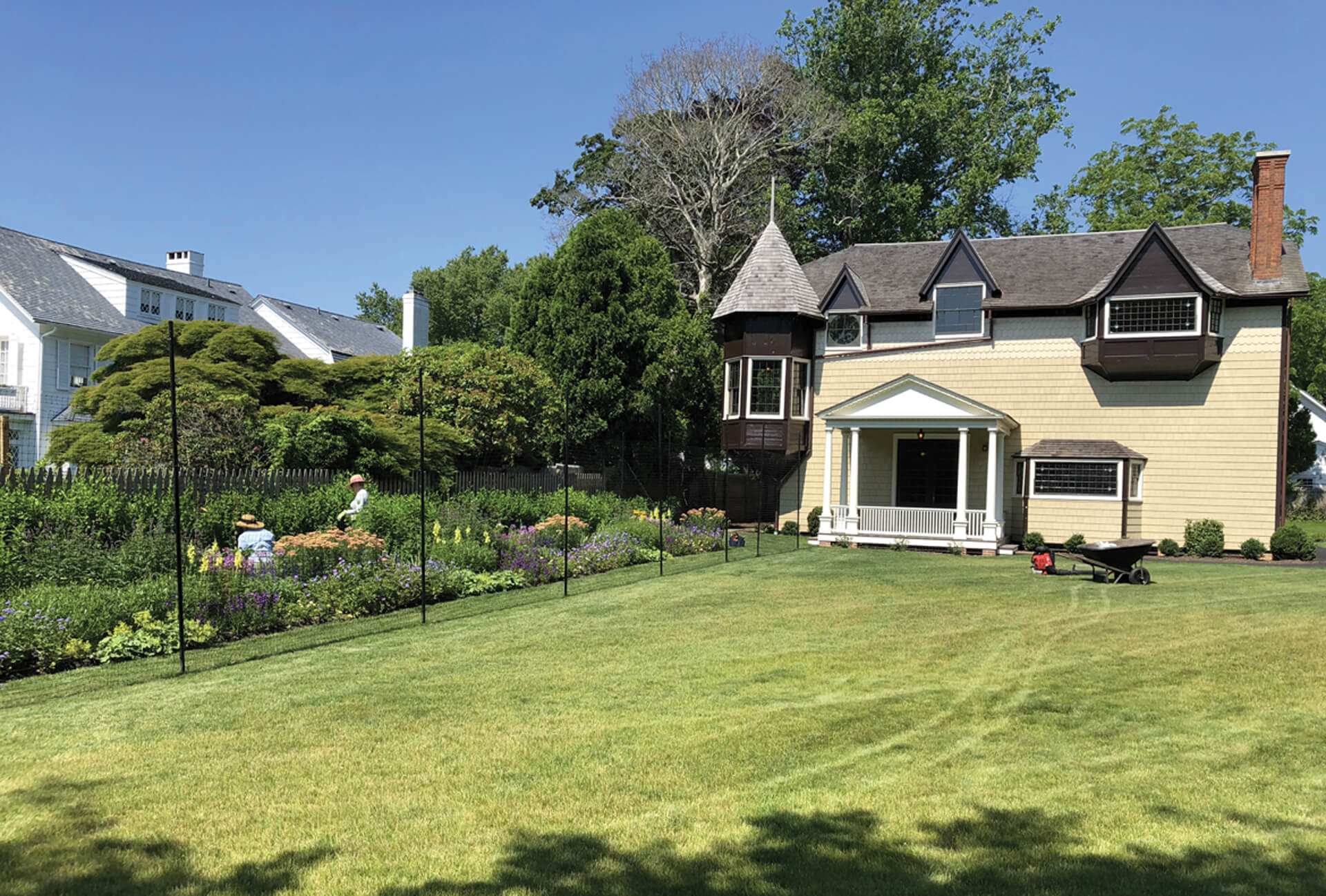Thomas Moran House Opens After Restoration

After years of hard work and dedication, the historic Thomas Moran House and Studio will be opening this weekend to the public. “It’s a soft opening,” Richard Barons, the chief curator for the project, as well as for the East Hampton Historical Society, said. “It is high time to get people in to see what we are doing.” He spoke as he carefully strung a rope through circa 1880 bedrails, which will eventually support a mattress.
He stopped working on the bed and gave a tour of the house, which was home to Thomas and Mary Nimmo Moran for five to six months a year from 1884 Thomas’s death in 1926. Mary Nimmo Moran died in 1899. They are both buried in the South Side Cemetery next to Town Pond.
Moran was a painter of the Hudson River School. His 1871 watercolor paintings of Yellowstone inspired the creation of the national park. Mary was an artist in her own right, specializing in etchings and landscape paintings.
The main room of the house is the studio. A large, airy, bright two-story room, it is where the two created many of their works. “The first floor is almost completely restored,” Barons said.
On display now in the large room, he said, is “a small exhibition of almost 50 etchings.” There is also, Barons said, a “small section of the room with sketches and watercolors and an even smaller portion of the room with oil paintings.”
Previously, when the Thomas Moran Society displayed the couple’s works, they focused on East Hampton-themed pieces. The palette on display now is much larger, Barons said. Also on display, literally, is Thomas Moran’s paint palette and some of his brushes.
Another feature on display is a large touchscreen, with information about the Morans and the house. For example, at the touch of a finger, up pops a description of Moran’s work process. “Because of the nature of Thomas Moran’s adventures and expeditions, his landscape works were usually painted in his studios. He sketched many scenes, and probably used photography to capture vistas in the field as inspiration for the final painting,” the board informs the reader.
At the same time the house, at 229 Main Street, was being built in 1884, a wave of construction was sweeping through Manhattan. Houses built in the early years of the United States history were being torn down, to be replaced by brownstones.
Moran saw this as an opportunity. He began gathering structural and ornamental elements from the New York houses being knocked down. For example, on the eastern wall of the great room, a window Moran salvaged from a candy store radiates light. The front doors to the studio came from that same store. The fireplace mantelpieces were rescued from two homes: one, a Federal period house, circa 1790-1810, the other a Greek Revival structure, circa 1825.
Several of the paintings on display in the studio show another aspect of the Moran House that is easy to overlook: the beautiful gardens on the property. “This is by Mary, looking toward Main Street through her garden,” Barons said, pointing at one painting. He pointed at another. “This is Paul Moran’s 1895 painting of his mother’s garden. He was their only son.”
The artwork comes from various collections, including the Moran Trust. Terry Wallace of Wallace Gallery contributed quite a few etchings. And, of course, the East Hampton Library contributed from its extensive collection.
In a back room on the first floor is a giant etching press, like the one Mary Nimmo Moran used. Also in a back room was the original slop sink Moran used when he was working.
The second-floor room where Barons was preparing the bed was the master bedroom. Almost none of the furniture actually belonged to the Moran family: That was disbursed a long time ago when the house was sold. However, Barons said, the furniture on display is all from the right period, and typical of the furnishings of a summer colony house of the time.
While the master bedroom will be fully furnished, the two guest bedrooms on the second floor will each house small exhibitions.
A staircase leads up to a second-floor turret, the room where the Morans stored their prints.
The restoration of the house took years, as it had fallen into a state of disrepair. It was left to Guild Hall in 2004 by its previous owner, Elizabeth “Boots” Lamb, upon her death.
According to Barons, Guild Hall used the house for a season or two to house summer workers. “That was not a very good idea,” Barons said. The Moran House was one of the first in East Hampton to be electrified. In the early 2000s, the house still had its original electrical wires. “Double wires with white porcelain insulators,” Barons noted. Guild Hall was in the midst of its own renovation project. The realization set in that a true renovation would be expensive. The answer was the formation of the Thomas Moran Trust, to which Guild Hall sold the house for $1.
The house had been designated a National Historic Landmark in 1965. “Most preservationists said that, because of the condition of the building, that it would be very easy to claim hardship, and just have it torn down,” Barons said about the time when the trust took ownership.
“Peter M. Wolf [chairman of the Moran Trust] was a very active person in the trust and he was able to bring in a lot of people, particularly summer colonists, who could be persuaded that this was a wonderful Victorian [landmark]. Also, they began working with consultants from the Metropolitan Museum of Art, the Houston Museum, and writer Phyllis Braff.” Braff is an art historian who has curated several of the Thomas Moran exhibits at Guild Hall. Braff was extremely important, he said, because of her knowledge about Moran.
Also, a member of the summer colony, Gary Tinterow, played an important role. “He was curator of art at the Met,” Barons said. “He certainly explained the bigger picture, the national if not the international importance of Thomas Moran.”
Mac Griswold, a garden historian, “stressed the role of the landscaping” in returning the house to its former glory.
The restoration project took on steam, Barons said, after Superstorm Sandy weakened the structure to the point where it was feared it would collapse.
Some experts advised taking the house apart, then reassembling it. Barons believed that if that path was followed, much would be lost.
The board knew it had to act quickly. “They knew they needed a contactor to take over the whole thing.” They turned to John Hummell, who had successfully restored a smaller structure on the property.
“The first thing they did was to raise up the house. They brought in a house mover. A foundation was put in place. We were very anxious,” Barons said. “We were able to work with the village and [historian] Bob Hefner. He was our architectural consultant. He was right down the street. We could stop in and make sure everything was going exactly the way it should be.”
Much of the plaster in the original house was lost. Painting the new plaster would be a challenge. Hummell brought in Jim Field, “one of the greatest paint companies out here. Jim Field and Sons painting. They really understand hand brushing.” Applying the paint by hand brush was vital to the walls having the proper texture.
Before he finished his tour, he stopped in a back room on the first floor. “Curator’s choice,” he called the series of etchings on display, each of which he had selected.
Barons finished his guided tour and returned to work in the master bedroom. Even soft openings have hard deadlines.
The Moran Studio opening celebration will be held on Friday, July 6, from 6 to 8 PM, as a benefit for the East Hampton Historical Society. The opening of the studio is dedicated to the memory of William Fleming, whose passion for the project helped accomplish the restoration of this National Historic Landmark. For more information or tickets to the opening benefit, visit www.easthamptonhistory.org.
t.e@indyeastend.com



